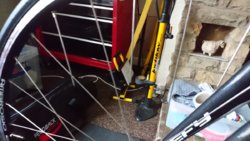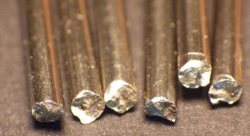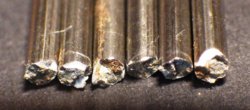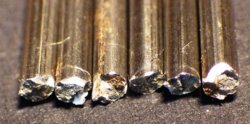OK,
@Velochris took the trouble to post the three broken spokes to me and they arrived yesterday. Thanks Chris.
I had a good look, slept on my thoughts, took some measurments and photos, did some more thinking and now I'll see if I can come up with a solution.
Firstly, these are SAPIM spokes, double butted, and made with 18/10 stainless steel. Normally this steel is rust proof.
Of the three spokes, two were outward bound and one was inward bound. For those non-wheelbuilders reading this, it means that two spokes were from the side in the hub flange where the head would have been on the inside of the hub and one, where the head placed on the outside of the hub.
All three broke at approximately the same place. This photo shows the relative position of the breaks and as you can see, the breaks are within a range of 30mm. In this photo the ends of the spokes are lined up and the two pieces of each spoke re-united with its breakaway sibling.
Note that I'm not using the term "Snap" as I don't like it. It is vague and, to me in anyway, implies a tensile break. These breaks are definitely cracks, as you'll see later on.
The fact that these breaks are all within a narrow band tells me that it is not a manufacturing fault. Spokes are made from continuous rolls of wire and manufacturing flaws would have shown up more randomly. The band of breakages here is narrow.
Secondly, I noticed, like Chris said, no nicks in the spokes. People holding spokes with pliers often cause such scores as the spoke twists in the pliers jaws and causes a neat break some years later when the original sin is long forgotten and buried. This is not the case.
However, there are definite signs of rust at and adjacent to the breaks. Have a look here.
Notice how the rest of the shank is clean and rust only appears at the break site. This tells me that the rust has something to do with the break. Had rust been visible elsewhere on the spoke I would still have attributed it to rust, but then perhaps blamed it on poor material.
Here's another picture of the rust.
Notice the very jagged crack edges. This is typical of fatigue and impurity intrusion. It is also typical of spokes made from the wrong material, such as for instance high-tensile steel. However, I've discounted that since the one spoke elbow, the one from the outbound spoke, is bend well beyond 90 degrees and had it been high-tensile steel, it would have broken there rather than in the middle of the smooth, unbent shank. I have turned on a bit of red in the photo software in an attempt to highlight the rust. The spokes are actually quite shiny and silver, not brown.
Next puzzle. From the orientation of the spoke elbow, I can tell where the rust marks are in relation to the wheel. All three of them are, within a few degrees, right on the side of the wheel. In other words, there were no rust marks on the inside of the wheel between left and right spokes, only on the outside. This has me thinking that something scratched the wheel and that something was made from mild steel. Something like a bike rack. Stainless steel contaminated with plain steel easily rusts. Anybody who has ever cleaned a stainless steel fridge door with steel wool or left some steel wool lying in the sink will know that SS rusts where it was contaminated. That bike rack or other mysterious object that scraped against the wheel had some naked steel that did the job.
This fact also sheds some light on Chris' wheelbuilding. Since the rust spots were not all exactly on the outside of the wheel and it is impossible for a flat object to scratch spokes on the protected front, back or inside, it suggests that there was still a bit of wind-up in the spokes after building. Chris can improve his wheelbuilding by paying more attention to de-twisting the spokes after building.
The rust spots are all localised and adjacent to the break.
Notice the jagged edges. Had these spokes "snapped" or broken in tension, these edges would have been nice and rounded or, as engineers say, necked or cup-and-coned.
Who said wheelbuilding is an art, not a science?





